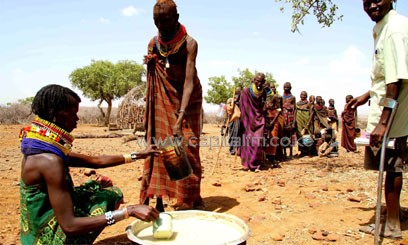
Operating at neglect without a national policy, the government has finally appreciated the regions potential and developed a national policy and the national framework for the regions development plan/XINHUA
Having faced the biased distribution of national resources and insecurity at the expense of the high potential areas of crop production, overlooking its wealth of livestock based economies, the ASALs has finally been recognized as an economic driver in the country.
Operating at neglect without a national policy, the government has finally appreciated the regions potential and developed a national policy and the national framework for the regions development plan.
“Accelerated investment in previously neglected regions is essential if all Kenyans are to have an equal chance of sharing in the promise and benefits of the government development plan,” the Minister of State for Development of Northern Kenya and other Arid Lands Mohamed Elmi said Tuesday evening during the launch of ASAL policy in Nairobi.
Elmi observed that the potential for Kenya’s economic growth is in the neglected 89 percent of Kenya’s ASAL total land mass that lies in the northern part of the country.
The minister noted that the policy has finally removed the injustices that has faced the region since the colonial era and henceforth includes the region as a contributor to the national development.
He said that the policy recognizes pastoralism as a legitimate form of productive land use and development just as farming and also incorporates the values of dry land goods within national economic planning.
“It also introduces flexible health and education system of high qualities responsive which are to the needs of the region and which reinforce traditional knowledge systems in pastoral areas,” he said.
Elmi further noted that the policy ensures that the devolved structure accommodates mobility and resource sharing across administrative boundaries.
The region has the potential in producing livestock, tourism and renewable energy and has to be looked at differently by recognizing its strengths and resources.
However, the area suffers from periodic droughts and the magnitude and severity has increased in the recent past as a result of climate change.
The policy aims at closing the development gap between northern Kenya and the rest of the country, which is a product of its historical experience and ensure food and nutrition security across the ASALs, where unpredictability is certain to increase as the impact of climate change deepens.
A commissioner with Revenue Allocation Fatuma Abdikadir called on the policy makers to change their attitude and start serious budgeting and development plans for the ASAL regions.
“Kenya cannot prosper when 89 percent of its land mass lack roads and other infrastructure,” she noted. She said that it is important that the potential of all regions are tapped to create equal development in the country to help reduce tribal unfairness in job opportunities.
Marjaana Sall, the European Union Deputy Head of Delegation called on the government to focus on infrastructure development in collaboration with the private sector.
She noted that the future growth requires bold vision and bold actions in collaboration with private and public sector that translations to development of the human capital.
“It is important that dialogue is created between public and private partnership to help create capacity to implement the policy,” she added.









































